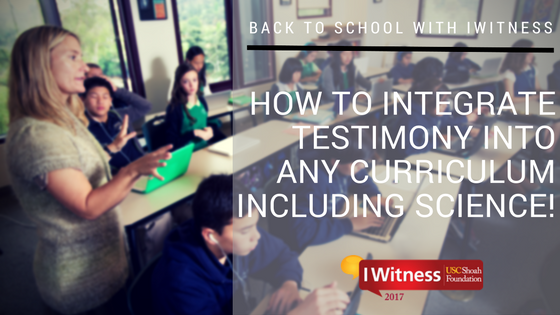How to integrate testimony into any curriculum including Science!
IWitness is a free educational website from USC Shoah Foundation that uses testimonies – personal stories – from survivors and witnesses of genocide to teach students worldwide the importance of compassion and in bringing about positive societal change. When telling educators about IWitness they usually think of it in the context of history, social studies and genocide education. However, the testimonies and resources in IWitness extend across curriculums. As an educator who has used IWitness to teach various subjects, units and topics here are some tips to integrating testimony into any curriculum, including Science.

Create a rationale
One of the most important things that we can communicate to students is why we teach them the topics and ideas that we do. In some subjects, like psychology or science, students may not initially understand why they’re watching genocide testimonies. If an educator explains to them that they’re watching a testimony on Eugenics and Nazi experimentation because it explains the social applications of their current discussion on genetics and heredity, they’re much more likely to engage with the material and think more broadly about their learning.
Teacher Tip: Download Using Testimony in the Classroom guide
Know the intended audience
It’s important to consider the abilities of students when choosing testimonies to use in a curriculum. Students who have no background on the Genocide against the Tutsi in Rwanda may not be able to fully understand a testimony from a Tutsi survivor. Conversely, Students who’ve had extensive lessons on the Holocaust may benefit more from a more specific or complex clip from a non-Jewish survivor or a liberator rather than a more straightforward clip.
Teacher Tip: Use connection videos in the IWitness dashboard to introduce your students to the context and history of topic.
Provide historical context
Presenting a clip of testimony without any historical context is similar to giving a student a paragraph from a book she’s never read: while it can be appreciated for its merit or importance, it would be hard for a student to comprehend it fully without knowing the whole story. In an IWitness clip, a Jewish survivor describes how his biology teacher would call up all the Jewish students to the front of his class and measure the size and shapes of their heads. This clip might not make sense without any context, but with knowledge of the period, students would understand that the Nazis assigned ideas of inferiority to certain physical features, like head shape, using science as a means of discrimination.
Teacher Tip: An easy way to integrate context is to watch testimony clips more than once: once before presenting context and once after, allowing students to think critically about their original hypotheses.
Encourage transparency
Along with the historical context that surrounds the content of testimonies, it’s important to also consider the context of the interview itself. Who is the interviewee and who is the interviewer? Why is she/he telling her story? What is the purpose of this testimony? Giving students the opportunity to understand why this interview with this particular person exists in the first place can give them a greater understanding of the importance of testimony.
Teacher Tip: Start with watch page with curated clips of testimony on 50 topics from eyewitnesses to the Holocaust, Genocide against the Tutsi in Rwanda, Guatemala Genocide and the Armenian Genocide.
Include additional resources
Using photographs, historical documents, timelines, films, and diaries along with video testimonies can help create a fuller sense of story for students. This is especially relevant when integrating testimony into science classrooms. Educators might combine a testimony of a witness to human experimentation with documents on medical ethics and photos/diagrams of the biological concepts explored in these brutal experiments.
Teacher Tip: Use the encyclopedias entries via the search tool. USC Shoah Foundation has combined with our partners, Genocide Archive of Rwanda United States Holocaust Memorial Museum, NIOD and Yad Vashem to offer you access to an extensive Holocaust and Genocide encyclopedia. You can save encyclopedia entries in your “Saved Items” folder to reference later.
Choose testimony and edit appropriately
One of the hardest, but most important parts of integrating testimony into a lesson is choosing the right clips for the right topics. Thinking about how a clip illustrates or enhances core ideas in the curriculum or emphasizes a particular theme can make all the difference in making a lesson resonate with students. A clip discussing Nazi pseudosciences might make a stronger impact in a science classroom, while a clip on resistance poetry might make more sense in a humanities context.
Teacher Tip: Search the IWitness Activity Library by subject area to find a multimedia activity that fits within your curriculum.